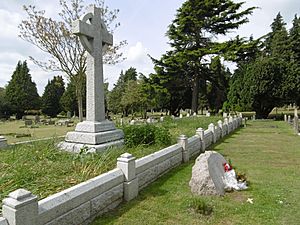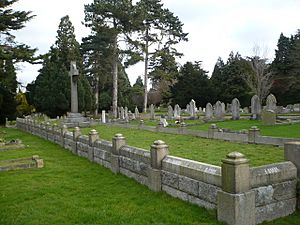Faversham Munitions Explosion Memorial facts for kids
The memorial to the victims of the 1916 Faversham Munitions Explosion is a special monument in Love Lane cemetery, Faversham, Kent. It's considered a very important historical building. This memorial was officially opened in 1917. It features a granite Celtic cross and stone structures around a mass grave. This grave holds the remains of 73 people who died in the Faversham explosion on April 2, 1916. A separate stone nearby lists the names of 35 other victims who were buried in different places. The memorial became a protected historical site in 1989 and its importance was upgraded in March 2016, just before the 100-year anniversary of the explosion.
Contents
About the Explosion
The very first gunpowder factory in England was built in Faversham way back in the 1500s. The business of making explosives stayed very important during the First World War. A company called the Explosives Loading Company built a new factory, number 7, in a marshy area called Uplees. This factory made TNT for bombs and mines.
What Caused the Blast?
Even though many safety rules were in place to stop sparks, a fire started on Sunday, April 2, 1916. It happened in a wooden shed that held 15 tons of TNT and 150 tons of another chemical called ammonium nitrate. No one is completely sure what caused the fire. An early report suggested sparks from a nearby boiler house might have set fire to empty linen sacks. These sacks were used to carry explosives and were piled up against the shed. This idea was later supported by an official report led by David Lloyd George, who was in charge of munitions.
The Disaster Unfolds
Workers and firefighters tried very hard to put out the fire. They also tried to move the explosives away from the area. But it was too late. Three huge explosions happened around 2:20 PM. The blasts created a large hole in the ground, about 120 feet (37 meters) wide and 20 feet (6 meters) deep. It could have been even worse! Thousands of tons of TNT stored elsewhere at the site did not explode.
At least 108 men and boys were killed in the explosion. No female workers were at the factory that weekend. The youngest victims were 17 and 18 years old, and the oldest were in their 60s. The dead included all the factory's fire brigade. Also, 20 workers from a nearby company came to help and were killed. Six soldiers from the 4th Battalion, The Buffs (East Kent Regiment), who guarded the site, also died. Many bodies could not be identified. Seven more people were listed as missing. Almost 100 others were hurt. The explosion was so powerful that it broke windows in Southend-on-Sea, which is 15 miles (24 km) away across the Thames Estuary. People heard the sound over 100 miles (160 km) away, with reports from Norwich and even France.
Why the News Was Kept Quiet
This terrible disaster was not widely known because of wartime news rules. The government kept a lot of information secret during the war. Many bodies were buried together at Love Lane cemetery in Faversham. This happened on Thursday, April 6, 1917. The service was led by the Archbishop of Canterbury, Randall Davidson. More burials took place on April 7 and 8. In total, 73 people were buried in the mass grave. Only 34 of them could be identified. The others were simply recorded as "male person unknown." The families of 35 other victims chose to bury their loved ones in different places. The factory was quickly rebuilt and started making explosives again.
The Memorial Site
The mass grave is a long, rectangular area, about 10 by 50 meters (33 by 164 feet). It is surrounded by a low granite border with short, capped stone posts. There are decorative urns on pillars at each end, next to steps. In the middle of this area stands a granite Celtic cross. It is about 3.8 meters (12.5 feet) tall and has three steps at its base.
Words on the Cross
The cross has a special message carved into it: "SACRED TO THE / MEMORY OF THE MEN / WHO DIED IN THE SERVICE OF THEIR / COUNTRY 2ND. APRIL 1916. // ‘FATHER IN THY GRACIOUS KEEPING / LEAVE NOW THY SERVANTS SLEEPING.’ " The last part is a quote from a hymn written in 1870 by John Ellerton. The names of the people buried in the mass grave are written in lead letters along the edge of the stone border. A separate stone nearby lists the names of the 35 victims who were buried somewhere else.
Building and Protecting the Memorial
The Explosives Loading Company paid for the memorial. They also promised to keep it well-maintained. The Archbishop of Canterbury, Randall Davidson, officially opened and dedicated the memorial on September 27, 1917. It became a Grade II listed building in 1989. This means it's a historically important building. Its importance was upgraded to Grade II* in March 2016, making it even more protected.
51°18′39″N 0°54′15″E / 51.310921°N 0.90422951°E



